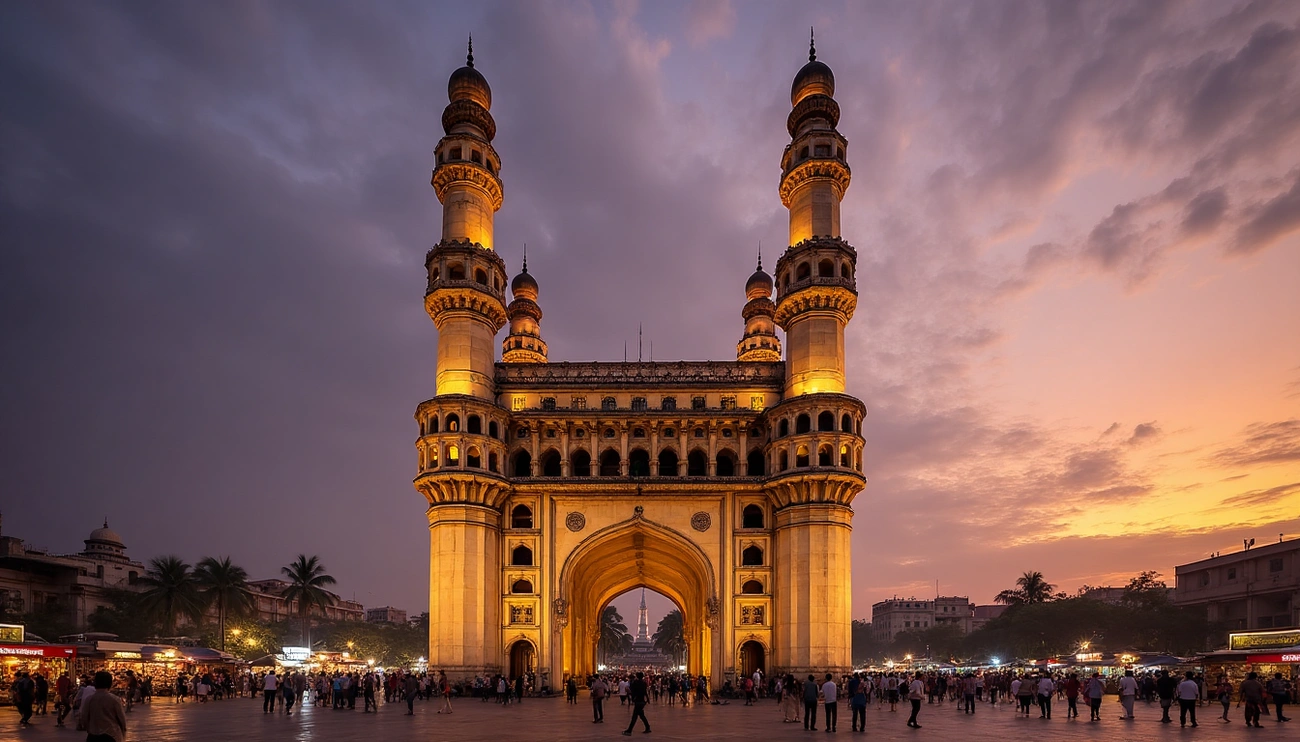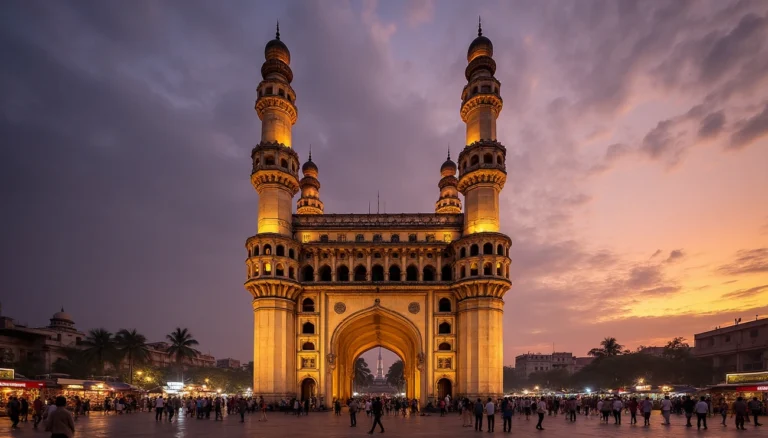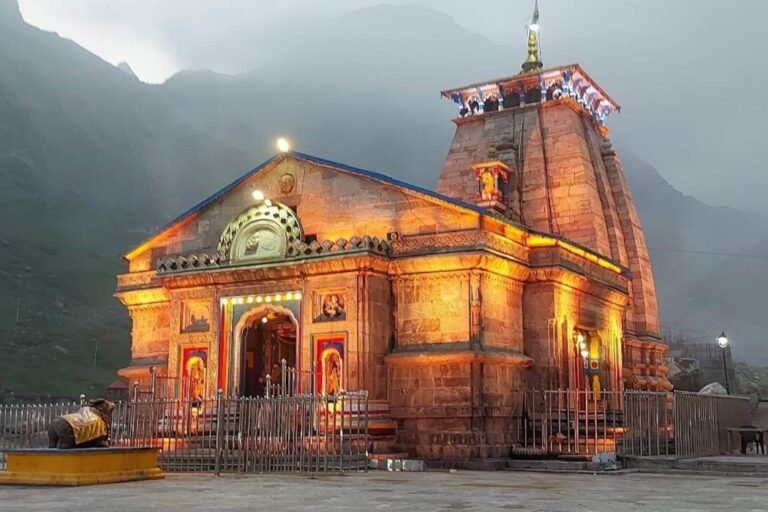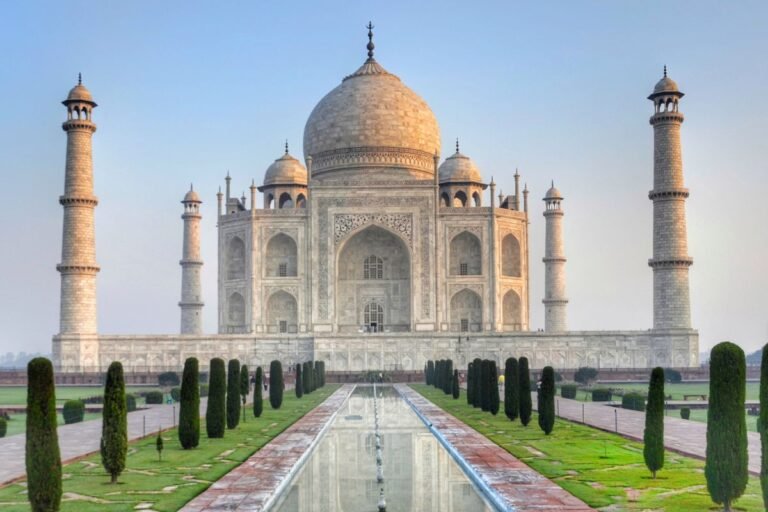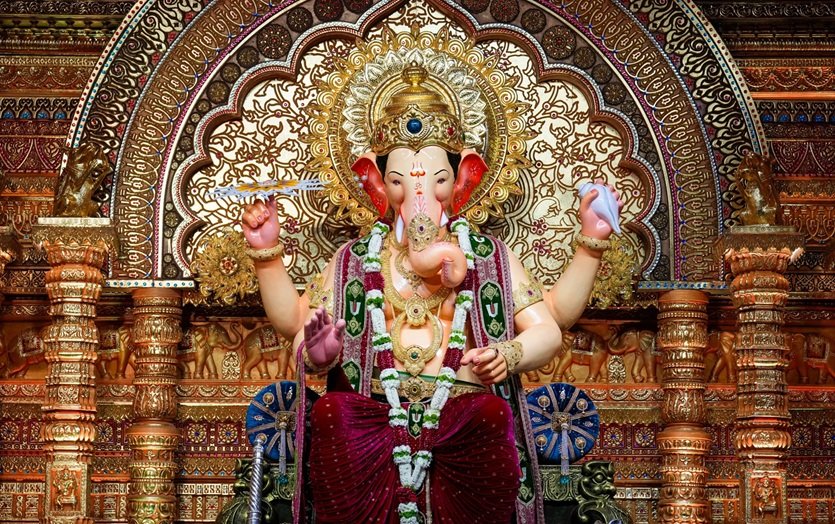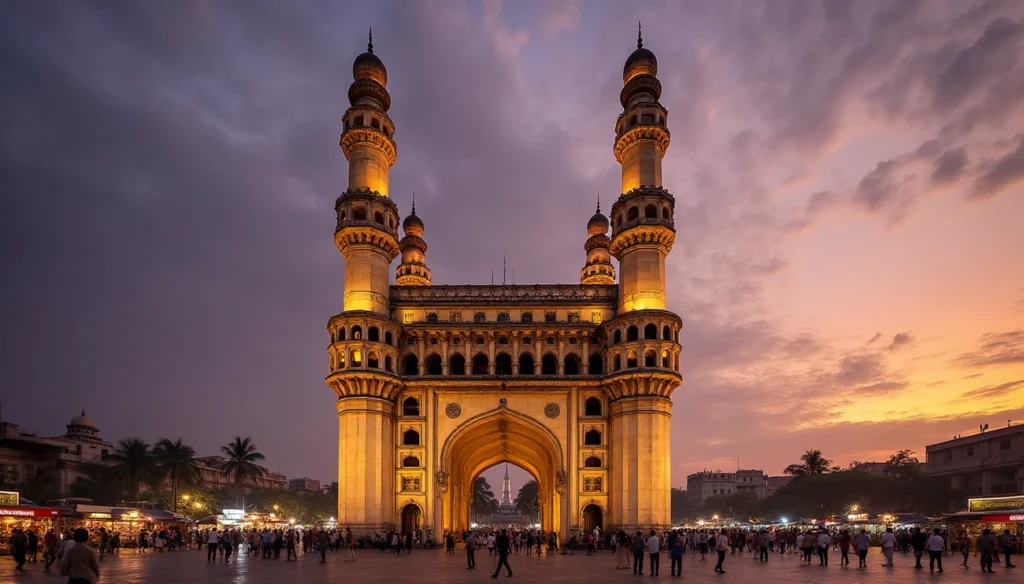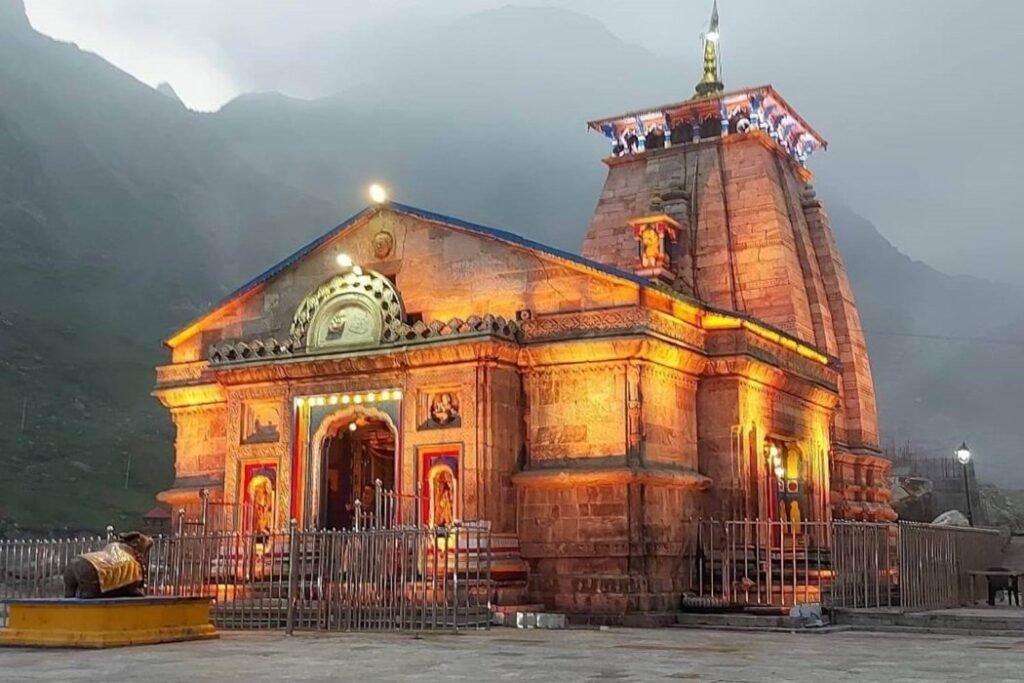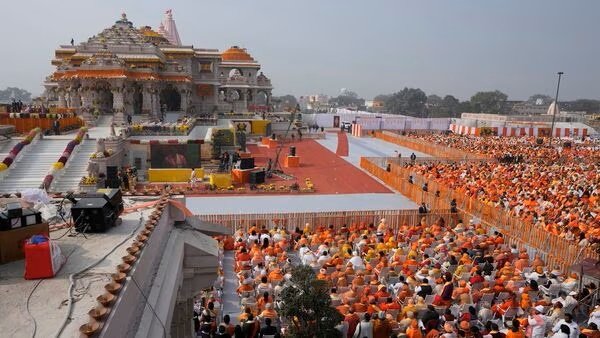Charminar Hyderabad in India
Standing majestically at the heart of Hyderabad, India, the Charminar has witnessed over 430 years of history since its construction in 1591. This iconic monument, weighing approximately 14,000 tons, isn’t just a tourist attraction but an enduring symbol officially incorporated into the emblem of Telangana.
During my explorations of Hyderabad’s cultural landmarks, I’ve discovered that Charminar holds stories far beyond its striking appearance. Built by Muhammad Quli Qutb Shah, the fifth king of the Qutb Shahi dynasty, this architectural marvel was constructed at a cost of Rs. 9 lakhs. Interestingly, one of the most compelling reasons behind the construction of Charminar was reportedly a deadly epidemic that swept through the region. The monument stands at the intersection of a historical trade route connecting the city to international markets through Machilipatnam port.
In this guide, I’ll take you through the hidden narratives of this 66-foot square structure that features four towering minarets reaching 184 feet into the sky. From its active mosque that has existed for more than 434 years tothe fascinating architectural details that blend various cultural influences, we’ll explore Charminar not just as visitors but through the eyes of locals who understand its true significance in Hyderabad’s identity.
Experiencing Charminar like a local
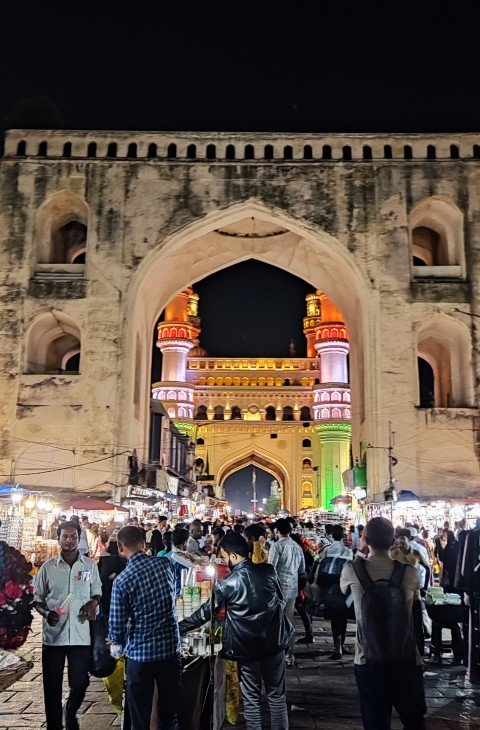
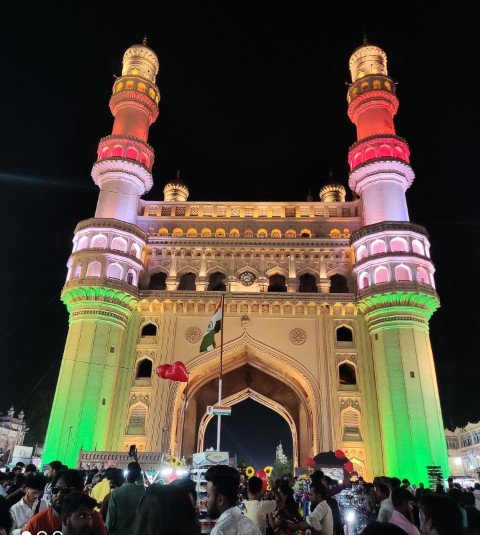
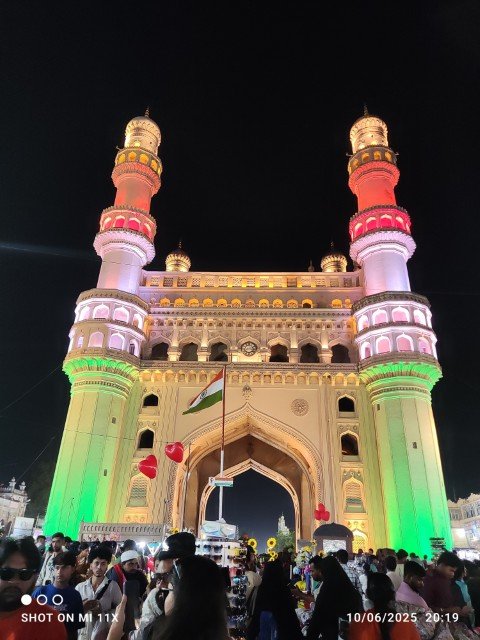
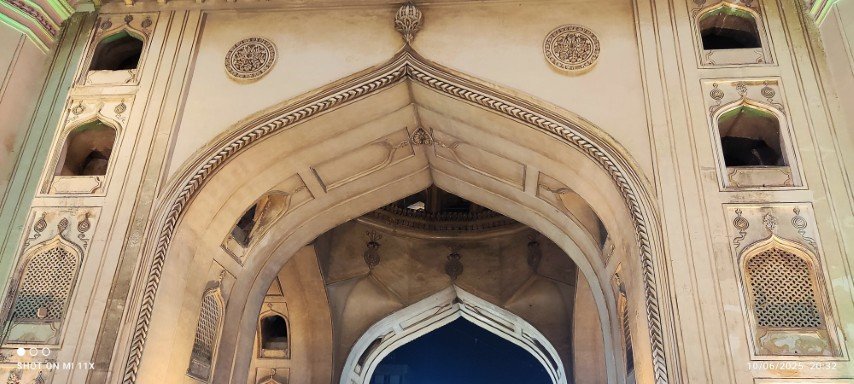
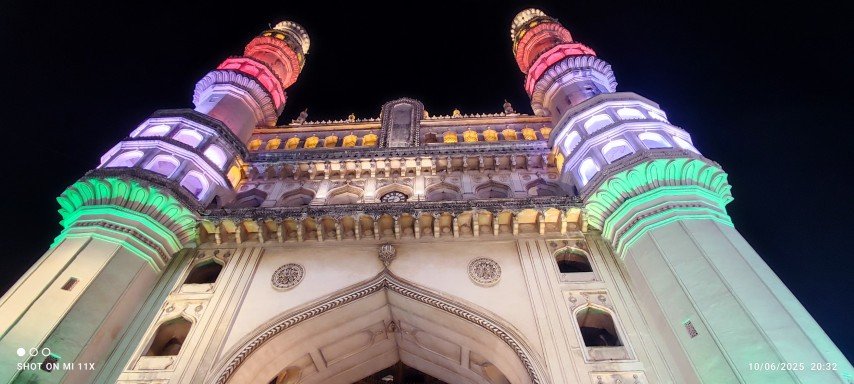
Best time to visit Charminar
For a truly pleasant experience, plan your visit between October and March when temperatures hover around 15-30 degrees Celsius. These winter months provide comfortable weather for exploring both the monument and surrounding bazaars.
If you’re looking to avoid crowds, early mornings offer a peaceful atmosphere to appreciate Charminar’s architectural details. Alternatively, evenings showcase the monument beautifully illuminated from 7:00 PM to 9:00 PM, creating a magical backdrop as the nearby Laad Bazaar comes alive.
One crucial tip from locals: avoid visiting on Fridays as this prayer day brings substantial crowds to the area. Additionally, weekends typically see higher visitor numbers compared to weekdays.
How to reach Charminar in Hyderabad
Reaching this central landmark is straightforward through multiple transportation options. The Hyderabad Deccan Railway Station (also known as Nampally) is approximately 5 kilometers away, well-connected to major cities across India.
For those flying in, Rajiv Gandhi International Airport in Shamshabad is about 18 kilometers from Charminar. From either location, you can choose between:
- TSRTC busses that operate regularly from major bus stands
- Auto-rickshaws or taxis for direct access
- Metro rail to MGBS station followed by a short auto ride
While the area currently lacks direct metro connectivity, the Green line will soon connect Charminar to other parts of Hyderabad.
What to expect during your visit
Charminar welcomes visitors daily from 9:00 AM to 5:30 PM. Entry fees are ₹25 for Indian nationals and ₹300 for foreign tourists, allowing access to climb up one level through the spiral staircase in one of the minaret towers.
Once inside, marvel at the intricate carvings on the pillars and architecture that blends Persian, Islamic, and Hindu styles. The panoramic view from the top offers a spectacular perspective of Old City.
Around the monument, you’ll encounter vibrant bazaars, the aroma of local delicacies, and colorful shops selling everything from pearls to traditional bangles. For photography enthusiasts, the monument and surrounding street life provide endless opportunities to capture authentic Hyderabad.
The hidden layers of Charminar’s past
Beyond the imposing structure lies a treasure trove of historical secrets that I’ve uncovered through years of exploring Charminar’s past.
The story behind its construction
Muhammad Quli Qutb Shah built Charminar in 1591 at the center of his newly established city of Hyderabad. Legend has it that the sultan constructed this monument to commemorate the end of a deadly plague that had ravaged the region. Furthermore, some historians believe it marked the spot where he first glimpsed his future queen, Bhagmati.
The name “Charminar” comes from combining two Urdu words: “Char” meaning four and “Minar” meaning tower or minaret. This architectural marvel wasn’t merely decorative—it served as the ceremonial gateway to the new city and represented the four directions of the Islamic world.
The mystery of the underground tunnel
One of Charminar’s most intriguing aspects remains its rumored underground tunnels. Local lore suggests a secret passage once connected Charminar to Golconda Fort, approximately 9 kilometers away. Though historians haven’t confirmed this connection, archeological surveys have indeed discovered tunnel segments beneath the structure. These passages likely served as escape routes for the royal family during emergencies.
The mosque and its continued use
On Charminar’s second floor sits a working mosque, one of the oldest in Hyderabad. Initially built for the royal family’s prayers, this mosque continues to serve worshippers today. Its eastern side features 45 prayer spaces where local Muslims gather, especially during important Islamic festivals.
The clocks and their legacy
Each of the four arches originally housed mechanical clocks installed during the Nizam period. Though these timekeepers no longer function, their circular frames remain visible. These clocks once regulated daily activities in the bustling marketplace below and served as important timekeepers for prayer schedules.
Essentially, Charminar isn’t merely a monument—it’s a living historical document where each brick tells a story of Hyderabad’s rich cultural heritage and royal legacy.
Architectural details that tell a story
Every stone of Charminar speaks volumes about artistic excellence and cultural fusion. As I run my fingers along its walls, I feel centuries of craftsmanship beneath my touch.
Design elements and their meanings
The monument presents a perfect square structure measuring 20 meters on each side. Four grand arches, each 11 meters wide and 20 meters high, form the monument’s core. These arches originally offered views of all four corners of bustling Hyderabad. The stucco decorations adorning the ceilings reflect meticulous attention to detail that has withstood centuries.
The four minarets and their symbolism
Rising majestically to 48.7 meters, the four fluted minarets are built directly into the main structure. Each minaret consists of four stories with ring-like balconies dividing each level. Interestingly, many believe these four towers represent the first four khalifas (prophets) of Islam. The minarets culminate in bulbous domes with delicate petal-like designs at their bases.
Blend of Persian, Islamic, and Hindu styles
Charminar exemplifies Indo-Islamic architecture with Persian influences. Although the arches and domes reflect Islamic styles, the balconies and exterior walls showcase intricate stucco floral ornamentation inspired by Hindu architecture. This harmonious fusion created what architect Mir Momin Astrawadi envisioned as a multicultural monument.
Charminar’s panoramic views
From atop Charminar, breathtaking views of historic Golconda Fort to the west and vibrant Laad Bazaar await. The 149 winding steps lead to this vantage point that offers an unparalleled perspective of old Hyderabad’s layout.
Exploring the surroundings of Charminar

Image Source: Expedia
Surrounding Charminar lies a treasure trove of historical sites that tell the complete story of Hyderabad’s rich heritage.
Laad Bazaar and its vibrant culture
Adjacent to Charminar, Laad Bazaar (also called Choodi Bazaar) has operated since the Qutb Shahi era. This kilometer-long shopping strip specializes in lacquer bangles studded with stones, hence its name – “laad” means lacquer. The market showcases exquisite craftsmanship where artisans spend up to 3 hours creating a single lac bangle. Moreover, you’ll find pearls, silverware, Kalamkari paintings, and traditional Khara Dupattas.
Makkah Masjid and its historical roots
Just 200 meters from Charminar stands Makkah Masjid, one of India’s oldest and largest mosques. Construction began in 1617 under Muhammad Qutb Shah and was completed by Mughal Emperor Aurangzeb in 1694. Its name derives from bricks made with soil brought from Mecca. The majestic prayer hall accommodates 10,000 worshippers beneath a 75-foot ceiling.
Chowmahalla Palace and royal heritage
Within walking distance lies Chowmahalla Palace, once the seat of Asaf Jahi dynasty and official residence of the Nizams. The palace features four courtyards, grand halls, fountains, and gardens blending Persian, Mughal, and European architectural influences. Its breathtaking Khilwat Mubarak (Durbar Hall) houses 19 spectacular Belgian crystal chandeliers.
Local food spots and street vendors
Old City’s culinary scene offers authentic Hyderabadi flavors. Visit Nimrah Cafe near Charminar for legendary Irani chai and Osmania biscuits. The area boasts delicious kebabs, biryani, and street foods reflecting both Telugu Hindu and Muslim influences.
Tips for navigating the Old City
Visit early mornings to avoid crowds. Dress modestly, particularly when visiting religious sites. Women must have dupatta/shawl for Makkah Masjid entry. Bargaining is customary in markets. Carry water and be vigilant about belongings in crowded areas.
Conclusion
Standing amidst the bustling streets surrounding Charminar offers more than just a glimpse of Hyderabad’s most iconic structure. After all, this 430-year-old monument transcends its status as a tourist attraction to embody the soul of the city itself. Throughout my explorations, I’ve discovered that Charminar rewards those who look beyond its imposing façade.
The stories behind Charminar—from its construction following a deadly plague to the rumored underground tunnels connecting to Golconda Fort—reveal layers of history often overlooked by casual visitors. Additionally, the architectural marvel with its perfect fusion of Persian, Islamic, and Hindu influences demonstrates how Hyderabad has long been a melting pot of cultures.
Visiting Charminar demands more than just admiring its four towering minarets. Therefore, I recommend exploring the vibrant Laad Bazaar with its traditional lacquer bangles, witnessing the grandeur of nearby Makkah Masjid, and experiencing the royal heritage at Chowmahalla Palace. The sensory journey continues through the aromas of Irani chai and authentic Hyderabadi cuisine that permeate the surrounding streets.
The best experiences at Charminar come from approaching it as locals do—by visiting during early mornings when the structure bathes in golden sunlight or evenings when illumination brings its intricate details to life. Certainly, climbing those 149 winding steps rewards you with panoramic views that tell Hyderabad’s story from above.
Charminar stands as both witness and participant in Hyderabad’s continuing narrative. My journey through its hidden stories has shown me that this monument represents not just architectural achievement but also cultural resilience. The next time you visit, look beyond the structure itself and experience the living heritage that makes Charminar truly the heart of Hyderabad.
Key Takeaways
Discover Charminar’s hidden depths beyond its tourist facade through local insights and centuries-old stories that reveal Hyderabad’s true cultural heart.
• Visit early mornings or illuminated evenings (7-9 PM) to avoid crowds and experience Charminar’s magical atmosphere like locals do.
• Explore the active 434-year-old mosque on the second floor and mysterious underground tunnels that may connect to Golconda Fort.
• The four 184-foot minarets blend Persian, Islamic, and Hindu architectural styles, symbolizing the four khalifas and representing cultural fusion.
• Immerse yourself in surrounding heritage sites: Laad Bazaar for traditional lacquer bangles, Makkah Masjid for spiritual history, and Chowmahalla Palace for royal grandeur.
• Climb the 149 winding steps for panoramic views of Old City while savoring authentic Hyderabadi cuisine from nearby street vendors and Nimrah Cafe.
Charminar isn’t just a monument—it’s a living testament to Hyderabad’s resilience, where every stone tells a story of plague survival, royal romance, and cultural harmony that continues to thrive after 430 years.

